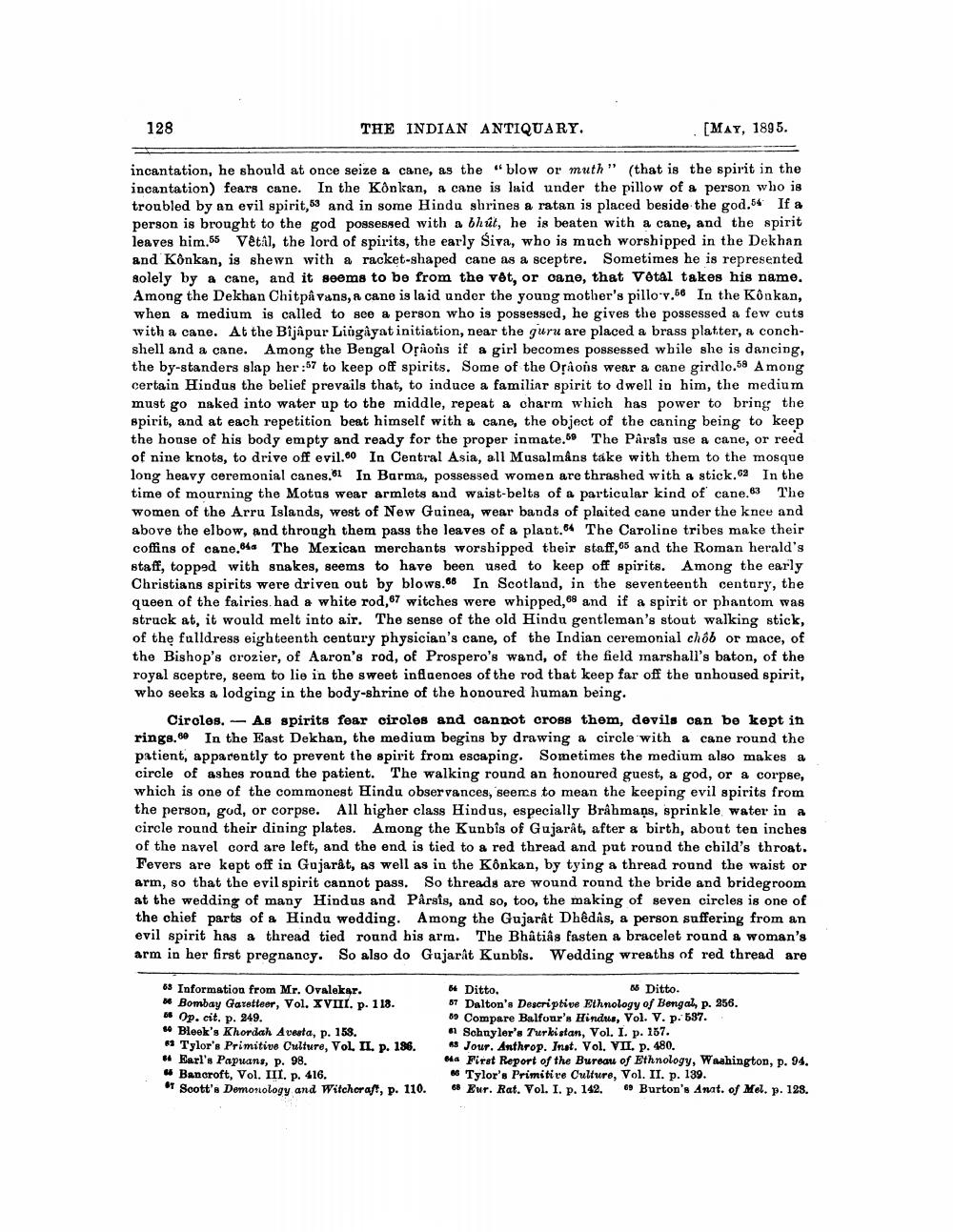________________
128
THE INDIAN ANTIQUARY.
[MAY, 1895.
incantation, he should at once seize a cane, as the "blow or muth" (that is the spirit in the incantation) fears cane. In the Konkan, a cane is laid under the pillow of a person who is troubled by an evil spirit,63 and in some Hindu shrines a ratan is placed beside the god.54 If a person is brought to the god possessed with a bhút, he is beaten with a cane, and the spirit leaves him.55 Vêtål, the lord of spirits, the early Siva, who is much worshipped in the Dekhan and Kônkan, is shewn with a racket-shaped cane as a sceptre. Sometimes he is represented solely by a cane, and it seems to be from the vet, or cane, that Votal takes his name. Among the Dekhan Chitpâ vans, a cane is laid under the young mother's pillo-7.56 In the Kônkan, when a medium is called to see a person who is possessed, he gives the possessed a few cuts with a cane. At the Bijapur Lingayat initiation, near the guru are placed a brass platter, a conchshell and a cane. Among the Bengal Oraons if a girl becomes possessed while she is dancing, the by-standers slap her:57 to keep off spirits. Some of the Oraons wear a cane girdlo.58 Among certain Hindus the belief prevails that, to induce a familiar spirit to dwell in him, the medium must go naked into water up to the middle, repeat a charm which has power to bring the spirit, and at each repetition beat himself with a cane, the object of the caning being to keep the house of his body empty and ready for the proper inmate.59 The Parsis use a cane, or reed of nine knots, to drive off evil.60 In Central Asia, all Musalmans take with them to the mosque long heavy ceremonial canes,61 In Barma, possessed women are thrashed with a stick.c2 In the time of mourning the Motas wear armlets and waist-belts of a particular kind of cane 63 The women of the Arru Islands, west of New Guinea, wear bands of plaited cane under the knee and above the elbow, and through them pass the leaves of a plant. The Caroline tribes make their coffins of cane.64 The Mexican merchants worshipped their staff,65 and the Roman herald's staff, topped with snakes, seems to have been used to keep off spirits. Among the early Christians spirits were driven out by blows.66 In Scotland, in the seventeenth century, the queen of the fairies, had a white rod,67 witches were whipped, 68 and if a spirit or phantom was struck at, it would melt into air. The sense of the old Hindu gentleman's stout walking stick, of the falldress eighteenth century physician's cane, of the Indian ceremonial chób or mace, of the Bishop's crozier, of Aaron's rod, of Prospero's wand, of the field marshall's baton, of the royal sceptre, seem to lie in the sweet inflaenoes of the rod that keep far off the anhoused spirit, who seeks a lodging in the body-shrine of the honoured human being.
Circles. — As spirits fear ciroles and cannot cross them, devils can be kept in rings.se In the East Dekhan, the medium begins by drawing a circle with a cane round the patient, apparently to prevent the spirit from escaping. Sometimes the medium also makes a circle of ashes round the patient. The walking round an honoured guest, a god, or a corpse, which is one of the commonest Hindu observances, seercs to mean the keeping evil spirits from the person, god, or corpse. All higher class Hindus, especially Brahmans, sprinkle water in a circle round their dining plates. Among the Kunbis of Gujarat, after a birth, about ten inches of the navel cord are left, and the end is tied to a red thread and put round the child's throat. Fevers are kept off in Gujarât, as well as in the Kônkan, by tying a thread round the waist or arm, so that the evil spirit cannot pass. So threads are wound round the bride and bridegroom at the wedding of many Hindus and Parsis, and so, too, the making of seven circles is one of the chief parts of a Hindu wedding. Among the Gujarat Dhêdas, a person suffering from an evil spirit has a thread tied round his arm. The Bhâtiâs fasten a bracelet round a woman's arm in her first pregnancy. So also do Gujarat Kunbis. Wedding wreaths of red thread are
68 Information from Mr. Ovalekar. ** Bombay Gazetteer, Vol. XVIII. p. 1 18. * Op. cit. p. 249. 4 Bleek's Khordah Avesta, p. 159. 63 Tylor's Primitive Culture, VOL. II. p. 186. # Earl's Papuans, p. 98.
Bancroft, Vol. III. p. 416. "Soott's Demonology and Witchcraft, p. 110.
64 Ditto.
Ditto. 07 Dalton's Descriptive Ethnology of Bengal, p. 256. 69 Compare Balfour's Hindua, Vol. V. p. 587. 61 Schuyler's Turkistan, Vol. I. p. 157.
5 Jour. Anthrop. Inst. Vol. VII. p. 480. 6a First Report of the Bureau of Ethnology, Washington, p. 94. 40 Tylor's Primitire Culture, Vol. II. p. 139. 68 Eur. Rat. Vol. I. p. 142. 69 Burton's Anat. of Mel. p. 128.




